#15th c. bohemia
Text

Effigy depicting Anna of Poland, Countess of Celje (died 1425)
#15th century#effigy#sculpture#15th c. sculpture#Bohemia#15th c. bohemia#holy roman empire#15th c. holy Roman Empire#early 15th century#mdpsculpture#1420s#medieval
119 notes
·
View notes
Text
More mystery with portraits of Hasburgs
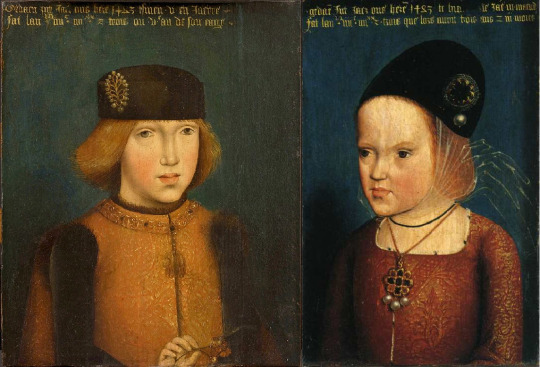
These two paintings are located in different museums, but are believed to be once a part. Currently they are labelled currently as Philip of Austria and Margaret of Austria, 1483, by Master of Legend of Magdalene.
And it's kind of a problem. Because at least the boy doesn't look like early work of this artist at all! Not even remotely close.
So other artists have been suggested instead, and for example the girl's has been most recently labelled as by Pierre Coustain.
Which doesn't make any sense either. Because while this was court artist in Burgundy, he specialized in making coat of arms and flags, sculptures etc. Like we can speculate on Pierre Coustain's involvement in these portraits(figures by Pieter van Coninxloo):

But only about the coats of arms. This guy wasn't portraitist.
...And you know me, I am nitpicker. I my motto is:
Never trust period label...because often times they are added centuries later.
So of course I checked the labels. On first glance, they seem as very genuine. This form of letters was around in 15 and 16th century.
...So I needed some help reading it, but luckily on wikipedia it was in description of paintings.
Girl's:

Gedaen Int Jaer ons here 1483 tsinen v en Jaerre/FAT LAN M.IIII.C.IIII.XX ET TROIS QUE LORS AUOIT TROIS ANS ET TROIS MOIS)
This was created in 1483 and she is 3 years and 3 months old.
(Very specific...oddly so.)

Gedaen Int Jaer ons here 1483 tsinen v en Jaerre / Fat Lan m. III c. IIII xx. z trois ou ve. an de son eage.
Once again it says year 1483, but that Philip is 3 or 5 years old.
Like how does nobody question this? You cannot be specific to month with girl, and not know how old the boy was!
Unless the label is not original at all! And likely not even done in 15th century. Because at those days, labels weren't really popular. They took off mainly in 16th century. And given the amount of mistakes I doubt Margaret nor Philip were even alive when this occured.
Because have they been, somebody would take greater care in getting it correct!
(And, If the text is from much later it is damn well-made.)
So if text is untrust-worthy, the dating of 1483 is also untrust-worthy, and then we cannot even be sure it is Philip or Margaret!

And though the boy doesn't fit Master of Legend's early work, he damn sure looks very alike to his late work! (1510-1527)
But then these kids cannot be royals from Netherlands. This is not its fashion from 16th century. We have portraits of Philip's kids raised in Netherlands, we know what they wore.
And while, yes the girl's hat looks bit like 1460-1470s male hats worn in netherlands, girls didn't wore this I checked. And given Netherlands were already back then northern capital of painters. It's very unlikely it wouldn't appear in art of that time from that country.
So possibly these are foreign royalty. But whom?
Well, artist started working around 1480/1490 and stopped about 1527. (Assuming we have correct artist.)
And the boy wears order of golden fleece around his neck. And clearly he is not adult. List of knights of Order of Golden fleece is on wikipedia and it includes when people got it and their birth year.
So finding people who got it before age of 15 in corrrect timeframe wasn't that hard.
Six candidates:
Philip of Austria (who it is currently identified as)
Henry VIII
Charles V
Ferdinand I, Holy Roman Emperor
Louis II, King of Bohemia and Hungary
Philibert of Chalon
But at age of 14 and 13, Henry VIII and Philibert are simply too old...to be depicted here. And Louis II's sister was older than he. And we know what Charles and his sisters raised in Netherlands wore.
Thus if not Philip and Margaret, the only other valiable option is Ferdinand and Catherine of Austria.
(if the list of candidates was complete...)
And it just so happens that if you put correct dimensions to these(in cm), and put them in order of birth, they don't look so weird...

Potentially this might have once been full set of siblings.
Done firstly around 1507(first four)
and rest after 1515, when Ferdinand became the member of the order.
...And if we compare what the girl wears with spanish fashion, then at least in examples from 1490s similiar hats were popular(not as much raised, but we always see them on adults. Maybe then the raise is not so high, and traluscent veils of this kind even much later(those are with cofia de tranzado)...this shape of neckline, also very popular in Spain at least around turn of the century.

In my research into iberian fashion, i didn't go that much into fashion after 1505(not in debt) and it's not ideal that I point to examples about 20 years prior to when I think it might be.
But it is a possibility, and would explain the resemblence.
...
However then we have to assume 2 more possibilities.
A) the list of knights of order of fleece was not complete...and we're missing candidates...and then once again, where does the fashion point us?...Spain in case of girl...
B) But what if the boy and girl don't belong together?
What if they just had same background(popular in Burgundian/Netherlandish court from 1450? to about 1507)
and same dimensions(by chance, or they were later cut to make them same dimensions)?
(C)what if both options? L)ist wasn't complete and boy and girl don't belong together?
Well, the boys who got orders of golden fleeces as kids were usually royalty, with whom Hasburgs had friendly relationship.
Only other option already not covered, would be either Christian II of Denmark-but he was made member in 1519-so he is on the list, as adult...
or John, Prince of Asturias and Girona. He married Margaret of Austria, in 1497 and died that same year. And Joanna married Philip of Austria in 1496.
We know Margaret's portraits were created in early to mid 1490s, likely to be sent to Spain, and probably Philip's also.
But what if Spanish send reply? And Hasburgs send their own painter, to paint Spanish royal children? That would also explain resemblence to Joanna's children. Because boy would have to be her brother, and girl Joanna herself.
Again, the boy seems to be later work of the master, but it was a workshop. It is possible one of its member simply became more prominent later in workshop's lifetime and it happened to be him who was sent to paint the boy.
And i cannot get further than this. Dendrology would be helpful here.
However as these portraits have year upon them, the institutions who own them think they have the correct date already. We can only hope they decide to test it anyway.
11 notes
·
View notes
Text
FRIEDRICH III
Holy Roman Emperor
A brief History... until his reunification of Habsburg Austria...
(born 1415 - died 1493)

pictured above is a portrait of the Holy Roman Emperor, by Hans Burgkmair (the Elder) from c. late 15th-early 16th century
-------------------- ~ -------------------- ~ --------------------
SERIES - On this day September Edition: Friedrich was born on 21 September 1415.
-------------------- ~ -------------------- ~ --------------------
FRIEDRICH was born on 21 September 1415, at Innsbruck in the County of Tyrol. He was the eldest son of Ernst I, Duke of Inner Austria and Cymbarka of Masovia.
He was born a member of the Leopoldian line of the HOUSE OF HABSBURG. This line had been founded following the division of the territories of the Duchy of Austria through the Treaty of Neuberg in 1379. On this occasion, two Habsburg lines were founded: the Albertinians (after his great-uncle Albrecht III, who became Duke of Austria) and the Leopoldians (after his grandfather Leopold III, who became Duke of Inner and Further Austria).
The Leopoldians in turn divided their own territories. By 1406 his father received Inner Austria (comprised of the Duchies of Styria, Carinthia and Carniola and his uncle became Friedrich IV, Duke of Further Austria (comprised of parts of Swabia, Alsace and Austria) and Count of Tyrol.
His father died in 1424 and he and his brother inherited Inner Austria sharing the title of Duke, under the Regency of their uncle. He became known as FRIEDRICH V, DUKE OF INNER AUSTRIA and his brother as Albrecht VI, also Duke of Inner Austria.
When they reached the age to rule on their own their uncle did not allow them. Only in 1435 a distant Albertinian cousin Albrecht V, Duke of Austria released them from the Regency.
Around 1439 his ambitions grew, as in June his uncle died and he became Regent to his cousin Sigismund, Duke of Further Austria and by October his cousin the Duke of Austria (who was also Albrecht II, King of the Romans; Albrecht, King of Bohemia; and Albert, King of Hungary and Croatia) also died, leaving no male heirs but a pregnant wife.
At early 1440 he was also elected as KING OF THE ROMANS and became Regent for his cousin's posthumous son Ladislaus, Duke of Austria (who later became László V, King of Hungary and Ladislav, King of Bohemia).
Days before his coronation as FRIEDRICH III, HOLY ROMAN EMPEROR in 1452, he married LEONOR, and Infanta of Portugal. She was one of the daughters of Duarte, King of Portugal and Infanta Leonor of Aragón. They had five children (check the list below), but only two survived into adulthood.
By 1453 the Duchy of Inner Austria was raised to Archduchy, so he became the ARCHDUKE OF INNER AUSTRIA, jointly with his brother.
And over the next years he succeeded in unifying again all Habsburg territories under his rule, as the Albertinian line became extinct with the death of Duke Ladislaus (the Posthumous) in 1457, and the whole of Inner Austria was left to him after his brother's death in 1463.
-------------------- ~ -------------------- ~ --------------------
Check my posts on FRIEDRICH III's children and their Royal Weddings!
FRIEDRICH III and his wife LEONOR had five children...
Christoph of Austria - died aged four months;
Maximilian I, Holy Roman Emperor - husband first of Marie (the Rich) of Burgundy, Duchess of Brabant, second of Anna, Duchess of Brittany and third of Bianca Maria Sforza;
Helene of Austria - died aged three months;
Kunigunde of Austria - wife of Albrecht IV, Duke of Bavaria; and
Johann of Austria - died aged six months.
#frederick iii#emperor frederick iii#holy roman emperor#holy roman empire#house of habsburg#habsburg#austrian royals#german royals#royals#royalty#monarchies#monarchy#royal history#austrian history#german history#european history#world history#history#albert ii#king ladislaus#history lover#15th century#history with laura
8 notes
·
View notes
Photo

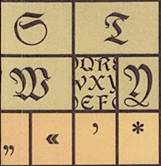

GRAP2199 | Week #5 Lecture | Relevant research
Gothic was the culminating artistic expression of the middle ages, occurring roughly from 1200—1500. The term Gothic originated with the Italians who used it to refer to rude or barbaric cultures north of the Italian Alps.
According to Christopher Wren's Saracenic Theory, Gothic style had nothing to do with the Goths, rather it was a style influenced by a number of factors including Saracenic art —an Islamic influence from the Crusades.
The Gothic spirit took hold in France, Germany and England where it was manifested through unhindered upward striving: the vertical supplanted horizontals as the dominant line in architecture; the pointed arch replaced the round arch of the Romans; the almond shape, or mandorla, was preferred. Gothic writing forms reflected this aesthetic.
From Type and National Identity by Peter Bain and Paul Shaw.
“Blackletter type is often misleadingly referred to as either Old English or gothic, two terms that are only partially accurate.Blackletter is an all encompassing term used to describe the scripts of the Middle Ages in which the darkness of the characters overpowers the whiteness of the page.
The basic black letter scripts are textura and rotunda, the former primarily associated with northern Europe and the latter with southern Europe. These are both book scripts.
Bastarda, a third category of blackletter originally confined to documents, was elevated to formal status in the 15th century French and Burgundian book of hours...Rotunda types soon followed, cut by printers in Switzerland, and more importantly in Italy.
After 1480 schwabacher types, based on local bastarda traditions, appeared in Bohemia, Switzerland and the German states.
Fraktur, another bastarda-influenced type style, developed from Imperial Chancery hands during the reign of Maximilian I. Its name is derived from the broken curves that distinguish many letters.”
Designhistory.org. (2011). Blackletter: The Gothic Hands 12-15th C.. Retrieved from http://www.designhistory.org/Handwriting_pages/Blackletter.html
P. & Shaw P Bain (1998). Blackletter: Type and National Identity.
2 notes
·
View notes
Text
Bratislovers and Awe-stria
We had never heard or read anything about Bratislava, but loved strolling through the green, hilly city with its interesting post-Soviet art, delightful craft cola and pastel coloured buildings. To be honest, we both wish we’d had more time to explore Slovakia, which is supposed to be a window into medieval life, with sleepy villages, wild animals and spectacular scenery.
Nonetheless, we made the most of our short time there. Bratislava is guarded by the stocky, storybook castle on the hill, which was rebuilt in the 60s after being destroyed by a fire in the 1800s and now sits pride of place over the old town.

The old town square, Hlavné Námestie, has great sculpture and is flanked by buidlings dating to the 14th Century.

Similarly old is St Martin’s Cathedral, an imposing Gothic church that doubled as a fortification, built as it was in the city’s ancient city walls.

The church’s surrounds as are pretty as the building itself, with a little vined courtyard, beautiful religious buildings for housing the adepts and a cobblestoned paths and roads.
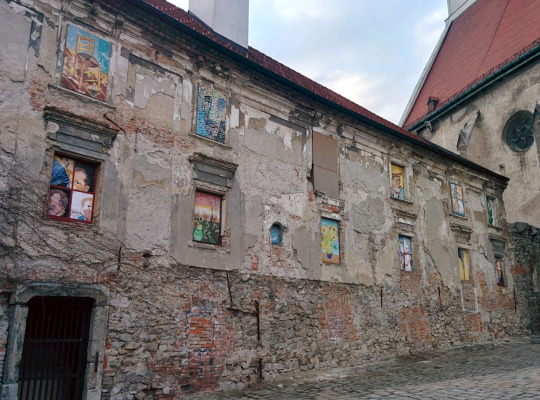
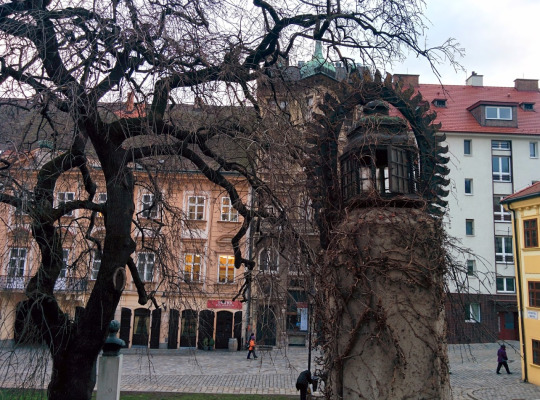
Our wandering continued, leading us to the funny statue of Cumil (“the watcher”), the manhole peeper who spies on the goings on of the old town and is accused of eyeing up all the passing ladies:

He’s apparently lost his head twice as a result of inattentive drivers, so has his very own “Man at Work” sign above him keeping him safe!
We also saw some other cute little galleries - check out the Renault!
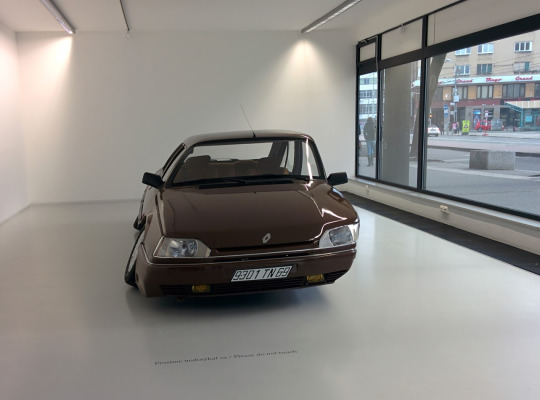
And then on to the eye popping baby blue “Little Blue Church” (Modrý kostolík), a masterpiece of the Hungarian art-nouveau style.
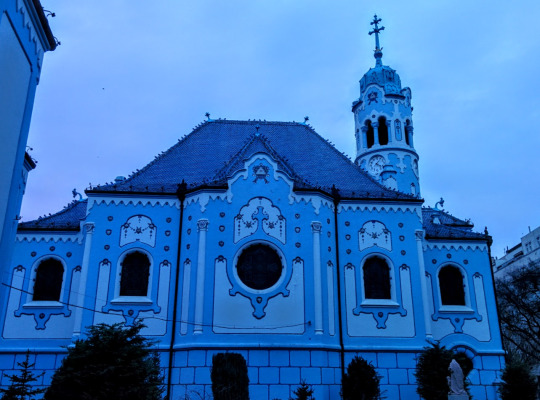
Having worked up a mighty hunger on our wanderings, we indulged in some meaty delights of the Slovak variety at the 600 year old brewery Bratislavský Meštiansky Pivovar.
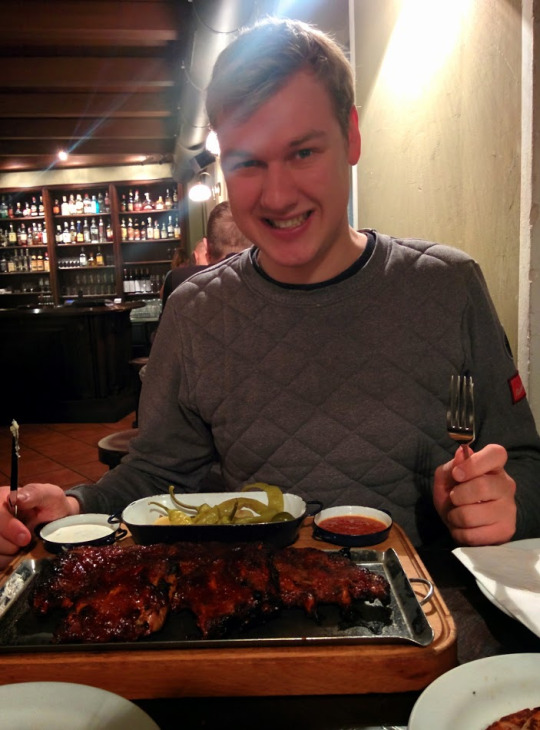
Not too much beer for us though, as we had a little drive to do in order to spend the night the night at the foot of the eerie Devínsky Hrad, a castle that dates back to the 600s, but in a location that has been a site of dense human settlement since the Neolithic era... That was to be where we lay our head in our little van for the night, spooky!
We made it through the night without any hauntings, and slogged up the hill in the beautiful sunshine to the archaeological site and castle ruins. The location of Devín Castle is on the confluence of the Danube and Moravia Rivers, so was of rather invaluable strategic importance for centuries. We saw the remains of a 1st C Roman tower, and the ruins of the 15th C castle, which is a maze of staircases, gardens, towers and walls. It was blown up by Napolean when he rampaged through the area. Check out the little door in the cliff - it’s a tunnel that passes through the entire cliff.
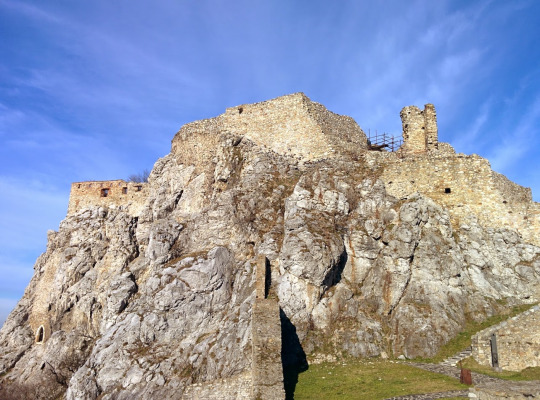
The watchtower below the castle, standing alone on a rock in the river is known as the Virgin’s Tower, (allegedly) being either the site of maidens being locked waiting for rescue, or the site where a young bride jumped to her death when her disapproving family killed her groom.

Refreshed from the vitamin D and ancient history, we pointed the van due west and drove into the Baroque heart of Austria - Vienna. We’d already been to both Innsbruck (briefly) and Salzburg in Austria, and had loved them both - especially the incredible ice cave near Salzburg! The rambling, majestic and downright regal Wien proved just as lovable. We parked up on the east bank of the Danube a wee way out of town and strolled into the city, starting with the cathedral, Stephensdom. It is unmissably grand, with its colourful tiled roof and outrageous Gothic decorations, and is smack in the centre of the Viennese old town. Oh, and it’s massive - this thing has 18 alters just in the main part of the church, with more in the chapels attached.

Inside, you’ve got a Gothic pulpit, a masterpiece of stone work, but dwarfed in the massive space.

In all this glitz, it’s important to keep it real: the sculptor of the pulpit did, carving himself staring out of a window under the stairs of the pulpit with such an expression of satisfaction on his face he’s earned himself the name fenstergucker - window gawker.

Having been guckers ourselves long enough, we treated ourselves to a delightful Sichuan meal in the suburbs and headed off to bed.

The next day we started with a tour of the Rathaus, an unfortunate name for a rather impressive building that has served as the city hall since 1833.

The building is Gothic, but in the Belgian style and arranged around Baroque courtyards, and is very pointy, lacy and spindly. Inside you have salons, festival halls and galleries which are all, of course, lavishly decorated.


Perhaps best of all, it has an active paternoster, or continuous elevator, which are increasingly rare because of how dangerous they are! They’re called paternosters because they work in a loop like rosary beads which are used to help recite the Lord’s Prayer, aka the Pater Noster. Good one, Europe.
Anyway, we very much enjoyed playing on it!

With a stop in a famous Viennese coffee house - all marble benches and whitewashed timber panels, a stroll through Margareten, a suburban district of Vienna and a peek at the neoclassical Musikverein, we were chilly enough to huddle into bed for the night!
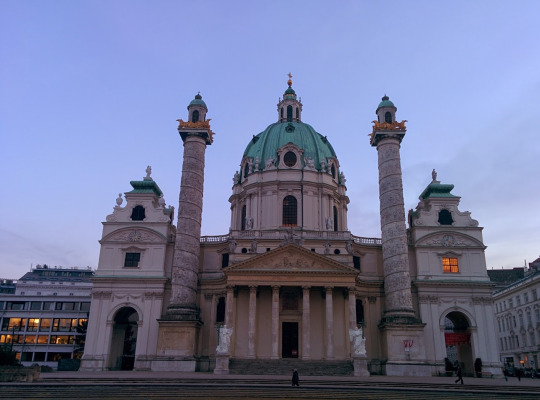
Working harder than we had in months were the riders who we saw practicing at the Spanish Riding School inside the Hofburg Palace the next day. The Lipizzaner stallions perform classical dressage to music within the palace while the public watch from beautiful balconies under glittering chandeliers. The riders wear uniforms dating back 200 years and the whole thing is like a trip to the ballet, but with white stallions! Photos are against the rules, but we snapped a couple of sneakies just for posterity.


The horses are treated like kings, including spending summers in the meadows and woods of Heldenburg and their winters at the palace!
With the afternoon at the Albertina Gallery, home to the biggest collections of prints and sketches in the world (think The Young Hare by Durer and pencil studies of The Last Supper) and afternoon tea at Demel, a patisserie established in 1786, we were fully getting into the high society life.


However, we were still urchins in reality, and living in a shopping mall carpark in the burbs, cooking toast grilled in a fish-shaped set of tongs in our sleeping bags every morning...

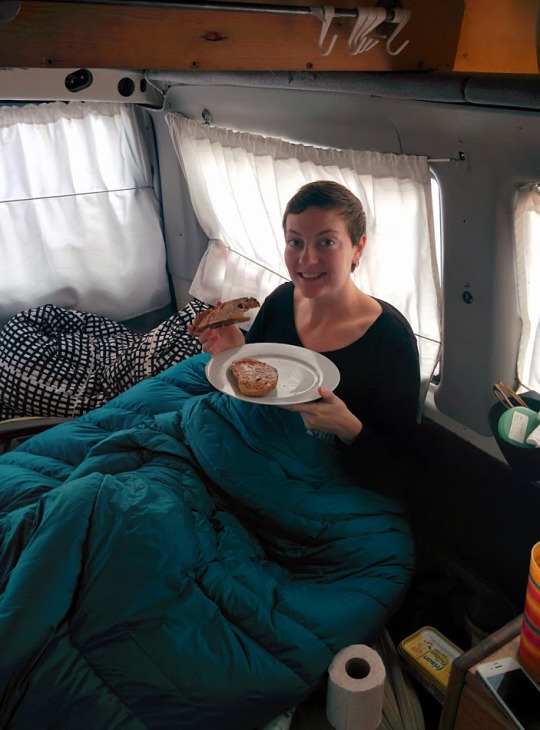
We also spent all of one evening going in a loop on one of the Viennese free trams just to warm up, so it wasn’t all Baroque architecture and gilt framed artworks!
However, we still got to spend our days carousing through palaces. We visited the seriously cold but beautiful Schloss Schönbrunn, the former imperial summer palace of the Habsburgs built in 1740 in the neoclassical style. It includes beautiful gardens that feature a whimsical (fake) Roman ruin and a gloriette, which is a European thing meaning a pavilion-like structure on a hill above a garden...


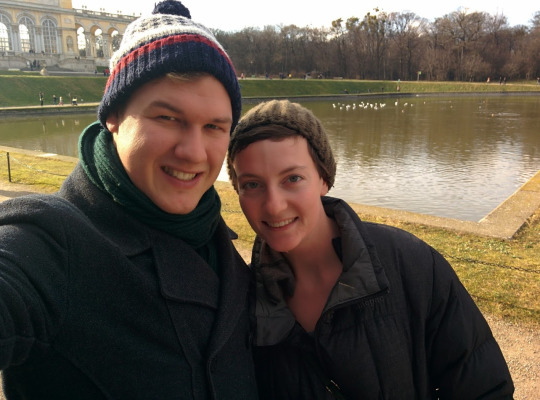
From the Habsburg delights of Austria, we decided to tootle back to see a little more of the Czech Republic, chugging three and a half hours to the Southern reaches of Bohemia to spend a few days in the sleepy wintery village of Český Krumlov where we got to relax and unwind on the medieval streets away from the Crowds of the big gilded cities!
1 note
·
View note
Text
I see Giotto di Bondone's frescoes and woodcuts as prototypes for tarot cards
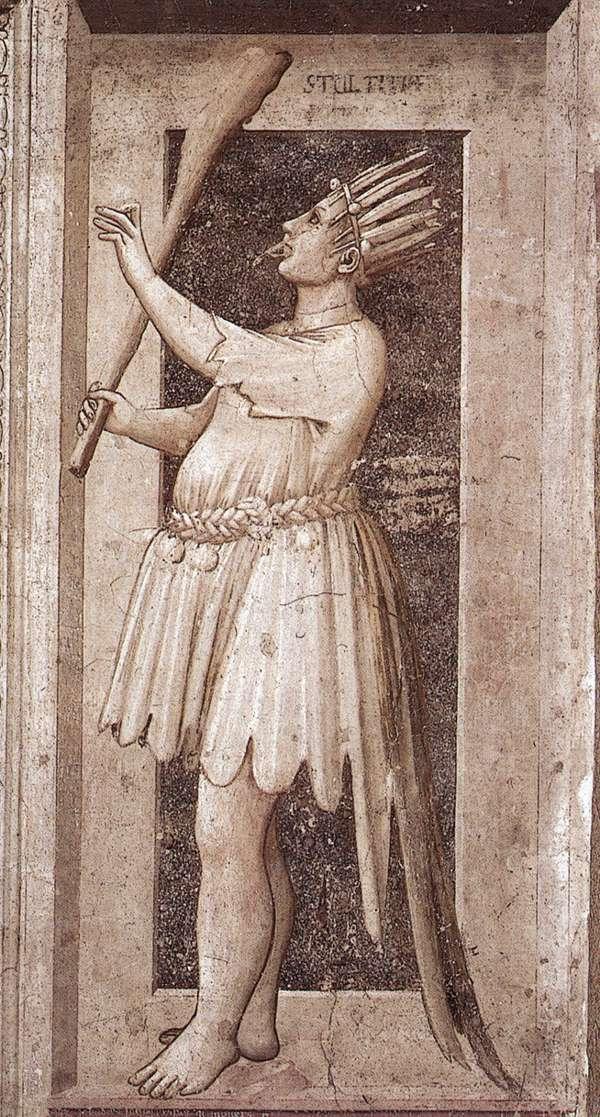
Foolishness, 1306, Giotto Di BondoneMedium: fresco
In fine art, the term "Proto Renaissance" refers to the pre-Renaissance period (c.1300-1400) in Italy, and the activities of progressive painters such as Giotto (1267-1337), who pioneered the new form of figurative "realism", which was fully developed by artists during the era of Renaissance art proper. Giotto's groundbreaking art did not however, represent the European or even the Italian mainstream. Derived from traditions inherited from Christian Byzantine art - which itself influenced the murals of Romanesque painting) - the style known as Gothic art, championed in Italy by the city of Siena among others, was still the predominant style of painting and sculpture. In fact the Gothic idiom survived well into the 15th century in the form of a style known as International Gothic, which became popular in many of the royal courts across Europe, notably France, Spain, Bohemia, and England. The Renaissance proper began around 1400 in the city of Florence, but its ideals and methods did not become a dominant force in European art until the mid-15th century.
Text source: http://www.visual-arts-cork.com/history-of-art/proto-renaissance.htm
0 notes
Photo
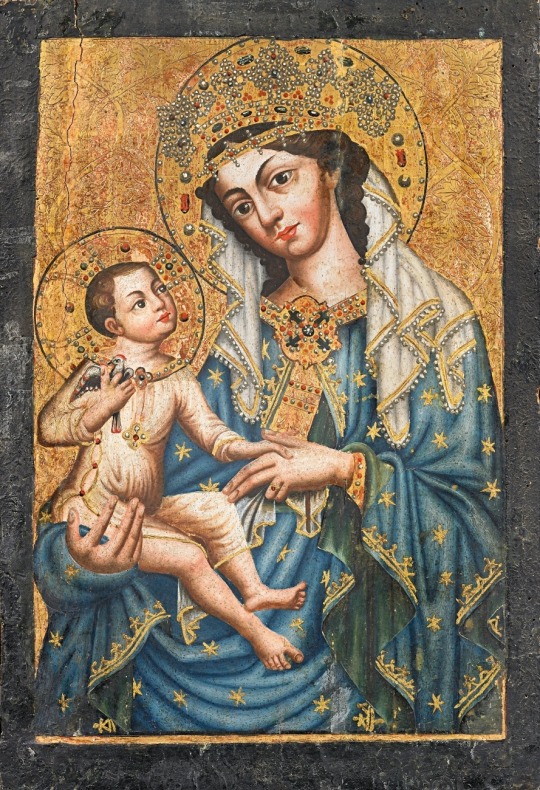
Mary and Child, Bohemian painter; 15th century
70 notes
·
View notes
Photo

“Visitation” from the St. James Altarpiece of the Convent of St. Agnes of Bohemia, c. 1430
33 notes
·
View notes